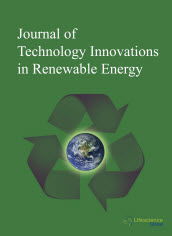jtire
|
|
|
Abstract: Considering complexity in process of the liquor’s evaporation-freezing and irregularity on the liquor surface, generating and developing model of ice on liquor surface was proposed by humidity difference based on fractal theory and diffusion limited aggregation model (DLA). The effect of gas flow velocity and humidity difference between gas and liquor surface on generating and developing of ice above liquor surface were analyzed by numerical simulation. The results showed that the fractal method could simulate the process generating and developing model of ice above liquor surface. It provided the new idea and method for the study of the liquor evaporation-freezing and ice growth. Keywords: Evaporation-freezing, fractal simulation, ice.Download Full Article |
|
|
|
Abstract: Water splitting photoelectrochemical cell (PEC) was fabricated in which the electrolyzer parts were made on a single chip. This was achieved by depositing an optically transparent Mn-oxide-TiO2 thin layer on the front of a triple junction amorphous Si photovoltaic cell which acted as the anode and the back stainless steel layer acted as the cathode under illumination of light. This single chip water electrolysis cell operates like an artificial leaf. Water splitting was observed by simply submersing the device in a basic electrolyte solution under solar simulated light of 1 sun (0.1 W cm-2). This self-driven PEC was found to produce hydrogen gas at the rate of 12.42 L m-2 h-1 and a solar to hydrogen efficiency (STHE) of 3.25 % from the collected H2 gas in 2.5 M KOH solution. No signs of degradation of this single chip PEC were observed during water splitting when the device was run continuously for 6 hours. Keywords: Water-splitting, Triple-Junctions amorphous-Silicon, photovoltaic.Download Full Article |
|
|
|
Abstract: This paper presents the complete modeling and simulation of Wave Energy ConversionSystem (WECS) driven doubly-fed induction generator with a closed-loop vector control system. Two Pulse Width Modulated voltage source (PWM) converters for both rotor- and stator-side converters have been connected back to back between the rotor terminals and utility grid via common dc link. The closed-loop vector control system is normally controlled by a set of PID controllers which have an important influence on the system dynamic performance. This paper presents a Multi-objective optimal PID controller design of a doubly-fed induction generator (DFIG) wave energy system connected to the electrical grid using Particle Swarm Optimization (PSO) and Genetic Algorithm (GA). PSO and GA are used to optimize the controller parameters of both the rotor and grid-side converters to improve the transient operation of the DFIG wave energy system under a fault condition as compared with the conventional methods to design PID controllers. Keywords: Grid integration, Wave Energy Conversionsystems, Doubly-Fed Induction Generator (DFIG), Vector control, Genetic Algorithm GA, Particle Swarm Optimization PSO.Download Full Article |
|
|
|
Abstract: Development of safe and effective hydrogen storage systems becomes a critical factor for further implementation of fuel cell and hydrogen technologies. Among new approaches aimed at improving the performance of such systems, the concept of porous materials-based adsorptive hydrogen storage is now considered as a long-term solution due to the reversibility, good kinetics and absence of thermal management issues. However, the low packing densities associated with the porous materials such as carbon structure materials, zeolites, metal-organic frameworks lead to the compromised volumetric capacity, potential pipe contaminations and difficulties in handling, when introducing the powdered adsorbents into hydrogen storage systems. Some efforts have been devoted to solve this problem by shaping the porous materials into beads, pellets or monoliths and achieve higher storage densities at more moderate temperatures and pressures. This review will firstly state the essential properties of shaped structures for hydrogen adsorption, and then highlight the recent attributes that potentially can be utilized to shape porous materials into specific configurations for hydrogen storage applications. Later, several testing techniques on structured porous material will be also discussed. Keywords: Porous materials,hydrogen storage systems, shaping process, application-specific configuration, packing density. Download Full Article |
|
|
|
Abstract: Lithium-air (Li-air) battery is a promising electrochemical system with unprecedented high energy density. However, many problems and challenges prevent its wide scale application and commercialization. Low oxygen diffusion rates and large voltage gap are two of the main problems in Li-air battery. These two problems are related to the materials used in the air cathode such as porous carbon materials and metallic catalysts. This review seeks to discuss various materials used in the air cathode for Li air batteries. Mechanism of reaction in air cathode will be elucidated and discussed. Keywords: Carbon material, porosity, capacity, catalyst, round-trip efficiency.Download Full Article |



